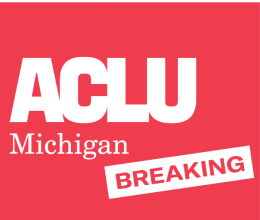

The most recent numbers showing lead levels in the water of Flint’s public schools continue to hit with spine-chilling impact.
Thirty months after an appointed emergency manager made the ill-fated decision to begin using the dangerously corrosive Flint River as the municipal water source for a city of nearly 100,000 people, the water is still not safe to drink unless it first passes through a filter.
That’s after a year of intense study by federal, state and local officials as well as some of the nation’s leading experts from a variety of universities.
That's after nearly a year of applying the mandatory corrosion-control chemicals that--in another horribly short-sighted effort to save a few bucks--weren’t being used until a coalition of residents, scientists from Virginia Tech, and the ACLU of Michigan conducted independent testing that proved lead levels were much higher than the city and state claimed.
Despite these efforts, though, the most recent available numbers (obtained via a Freedom of Information Act request) are enough to make any parent shudder. For instance, in tests conducted in March and April, one sample from Brownell STEM Academy produced water that contained 412 parts per billion lead. Durant-Tuuri-Mott Elementary reached a high of 614 ppb. Eisenhower Elementary and Doyle/Ryder Elementary both topped 1,500 ppb. And at Holmes STEM Academy the highest reading came back at 2,084 ppb.
Keep in mind that the safe level of lead is zero. And the federal action level is 15 parts per billion.
So yeah, the numbers are very scary. And the scenario gets even scarier when you consider the lead levels children were being exposed to before the state was forced to admit the truth, before those officials alleged to have concealed the truth were charged with multiple felonies.
Moreover, as Virginia Tech scientist Marc Edwards pointed out at a press conference in September 2015, the biggest concern isn’t having lead in your water. It is having lead in your water and not knowing about it. Thanks to the tireless work of Edwards and his team, as well as the ground-breaking efforts of a cadre of Flint residents, the world now knows about the lead lurking unseen in Flint’s water – and in the water in cities across the nation.
But Flint is unique, because the people there had no choice but to use the foul river water being forced on them by the state. In March 2015, the City Council voted to return to the cleaner, safer water coming from Detroit’s regional system--but the appointed emergency manager overruled the vote, saying the people of Flint couldn’t afford anything better than the rust-colored, foul-smelling swill being pumped from the river into their homes.
So the school children of Flint aren’t supposed to be drinking from the fountains now because the danger is known and being addressed, and they are being given bottled water for the time-being.
But the tragedy is in those 18 months that they and their parents were being assured by officials that the water was safe. The lead in that water was causing irreversible damage. IQ loss. Behavioral problems. Learning disabilities. Problems that will shadow them for the rest of their lives.
Significant progress has reportedly been made in reducing overall lead levels throughout the city. And in the schools, plumbing fixtures containing lead have been identified and parts replaced. Filters have been installed.
But making the water safe to drink is just one of the issues that the state needs to address.
During his sworn testimony in front of Congress, Gov. Rick Snyder described the Flint water disaster as a “failure of government at all levels.” That description is maddening, and not just because of its intentional passivity. It was, first of all, not a failure, but a series of deliberate actions that lead to the poisoning of a city.
Moreover, when he talks about the failure of government at all levels, that implies that there was something akin to an actual democracy in place in Flint. But that wasn’t the case. Democracy had been hijacked, with an austerity-driven autocracy installed in its place.
As for the federal Environmental Protection Agency, the agency’s lack of action is indeed scorn-worthy. But for Snyder to spread the blame as if it is something that should be shared equally is shameful. It is akin to a serial killer saying the fault lies in the cops who failed to catch him sooner and stop the bloodshed.
And for those misguided souls who might think that an overwrought analogy, we need only point to the 12 known fatal cases of Legionnaire’s Disease that are being linked to the use of river water.
You don’t need to take our word for who shoulders the bulk of the blame for this crime against humanity. A task force appointed by the governor himself makes it clear that it is the state, and the state alone, that caused the poisoning of Flint, a city where 57 percent of the population is African American, and 40 percent of the people live below the poverty line.
The report’s authors are unequivocal:
“The role of the emergency managers in Flint (in combination with MDEQ’s failures) places primary accountability for what happened with state government."
And with that accountability there must be responsibility to do everything humanly possible to mitigate the damage done to the residents of Flint--especially its children.
Which is why the ACLU of Michigan has filed a federal lawsuit seeking to force the state to live up to its moral obligation to provide Flint’s schoolchildren all the services and resources necessary to ensure that a generation of Flint children are able to reach their full potential, and live productive lives.
Providing an adequate education to the children of Flint was already an uphill challenge before this crisis hit. The school district is laboring under the burden of a $10 million deficit. Teachers are doing their best, but some classes have as many as 40 students in them. In a city rife with poverty, children were already being forced to overcome much.
The lead crisis has made the challenges even greater, the hill to climb even steeper and more difficult.
Much is being made of the resources being poured into Flint. But, as media coverage wanes, residents rightfully complain that still far too little is being done to provide the immediate help they desperately need.
And what will that flaccid political will be like once the spotlights fade even more?
You know the answer to that.
Which is why we need the courts to lay down the law and mandate exactly what must be done.
The children of Flint deserve nothing less.
"During his sworn testimony in front of Congress, Gov. Rick Snyder described the Flint water disaster as a “failure of government at all levels.” That description is maddening, and not just because of its intentional passivity. It was, first of all, not a failure, but a series of deliberate actions that lead to the poisoning of a city."

